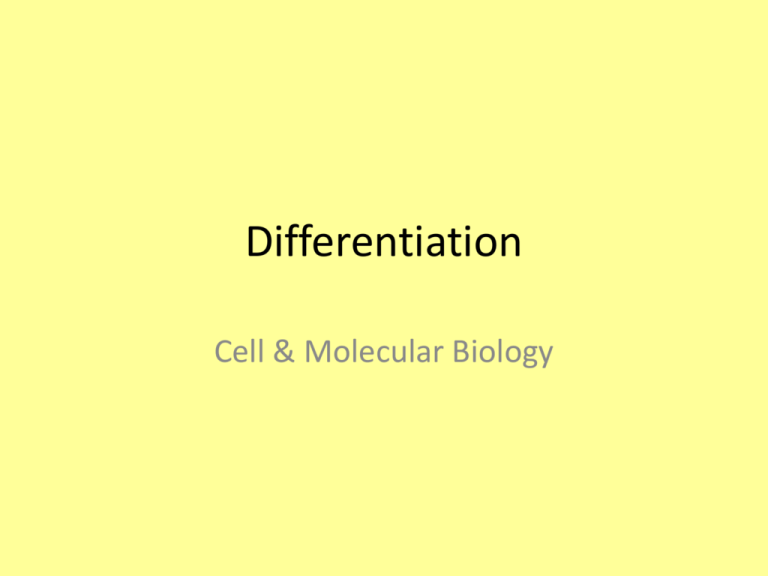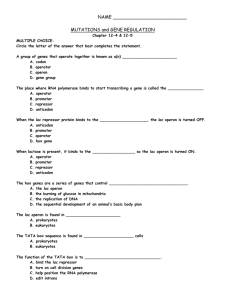Differentiation & lac operon 2013/14
advertisement

Differentiation Cell & Molecular Biology Genetic Control • All cells in the body have the same genetic information • Not all cells are identical. • Cellular differentiation depends on changes in gene expression resulting in genes being switched on or off • Cell function and protein synthesis – Proteins are synthesised according to DNA base sequence. – Cell function depends on a variety of proteins – Some genes that code for essential proteins (respiratory enzymes) are ‘switched on’ in all cells. – Those that are specific to that particular cell (haemoglobin in red blood cells) are switched on where others that are unnecessary to that cell are ‘switched off’ (genes for antibody production). Advantage to Organism • Protein synthesis requires a number of resources. • Genes that are not required remain switched off and therefore save –Energy and resources –(ATP & amino acids) Stem Cells & Differentiation • Plants have areas of unspecialised cells (meristems) that are capable of dividing and differentiating into any other cell type (totipotent) Stem Cells & Differentiation All animals have a basic body plan that begins the division and differentiation from zygote to fully developed organism. This development is influenced by two factors; 1. A programme of genes that specify the pattern of the body, 2. Local cell interactions that induce different parts of the programme Stem Cells & Differentiation Adult animals have regions of stem cells that can vary in potency. eg Multipotent stem cells found in bone marrow have limited abilty to differentiate into blood cells. Control of Gene Expression • Jacob-Monod hypothesis of gene expression in prokaryotes (e.coli) simplifies the mechanisms by which genes may be switched on or off in the presence or absence of an inducer Then lac operon • An operon is a region of DNA that contains an operator gene that controls the expression of the structural genes which make the proteins or enzymes coded for. The lac Operon • Operon that controls lactose metabolism by the synthesis of the enzyme -galactosidase. • Regulator gene codes for repressor molecule • Repressor molecule binds to operator • Operator gene switched off by repressor molecule • Operator switches off structural gene as transcription enzyme cannot continue to structural gene • Structural gene does not express -galactosidase The lac Operon • In the presence of lactose, the repressor molecule binds to the lactose prevents binding to operator gene. • Operator gene switched on • Structural gene switched on • Gene expression and synthesis of -galactosidase Lactose is the inducer of gene expression







